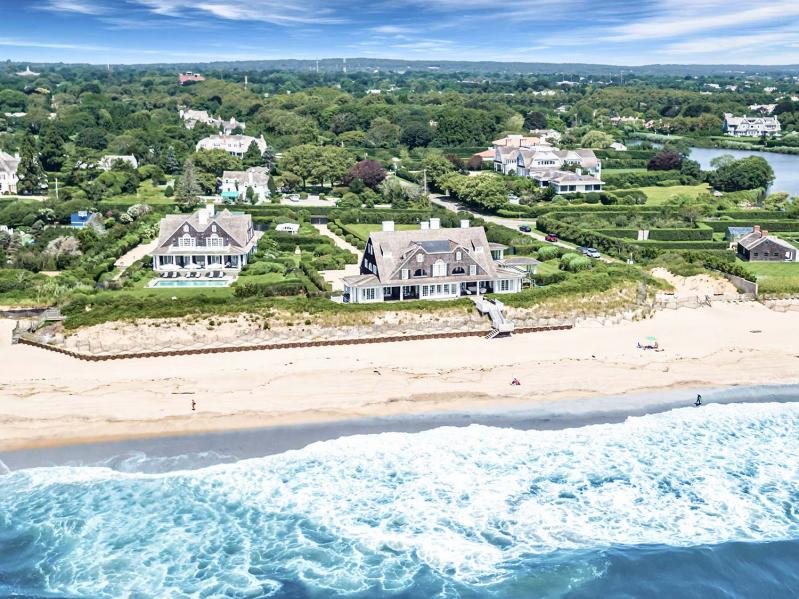La Dune, an iconic property in Southampton once listed for $150 million, was sold by Sotheby’s Concierge Auctions last month for $88.48 million in a bid placed over the phone. It was the most expensive property ever sold in a real estate auction on the South Fork.
After a 12-percent commission, it nets the seller, Louise Blouin, $79 million if approved by a bankruptcy judge on Tuesday. Ms. Blouin purchased the property, two lots located at 366 and 376 Gin Lane, in the late 1990s for 13.5 million.
The name of the buyer has not yet been disclosed.
The listing brokers were Harald Grant of Sotheby’s, Cody Vichinsky, president and founding partner of Bespoke Real Estate, and Tim Davis, of the Corcoran Group.
The initial starting bid of $66 million included $38 million for one parcel and $28 million for the other. On one is the original house built in 1888; on the other, a house built in 2000. Together they boast 22,000 square feet of space, 19 bedrooms, and 16 full bathrooms. A 400-foot bulkhead along the shore has so far protected the houses from the Atlantic Ocean.
“The house is set right into the dune (‘fabulously sited, if ecologically incorrect by today’s standards’ Sam White says),” reads a 1995 Architectural Digest article by Paul Goldberger, written after the house was completely renovated by Carl Spielvogel and his wife, Barbaralee Diamondstein, the owners before Ms. Blouin. Mr. White oversaw a large reworking of the property in the early 1990s. In the same article he wondered if his great-grandfather Stanford White was the architect, or rather Bruce Price. “Its architectural provenance has never been confirmed,” Mr. Goldberger wrote.
Recent storms have washed away steps that led to the beach from the bulkhead, “But the house never gets touched,” Mr. Grant said in a phone call. “As scary as it looks, could a tidal wave come through? Sure. But in all the storms, including the 1938 Hurricane, the home has been fine.”
Seven bidders, three in person, bid the lots up in $2.5 million increments. Ultimately, the buyer purchased both as a package. “The gentleman who bought it was very smart and realized that the value of the property was in the whole rather than its separate parts,” said Mr. Grant. “Where else can you get two oceanfront properties next to each other? He hit the home run by getting both of them.”
For Mr. Grant, it was the first time in over three decades as a real estate broker that he was involved in an auction. (Mr. Grant represented the property when Ms. Blouin purchased it too.)
“Selling a property at this price point is incredibly difficult,” said Chad Roffers, the founder and C.E.O. of Sotheby’s Concierge Auctions. “The pool of buyers is small, and time isn’t on your stand. Our role as auctioneers is accelerating and marketing the timeframe.” The auction is an event placed on the calendar, something to look forward to and participate in.
“We were there for six hours,” said Mr. Grant. “But at the end of the day, you have to close the auction.”
According to an information sheet provided by Concierge, it only accepts one in 20 properties to auction. “If a luxury property hasn’t sold in 90 days, it sits for three to five years and eventually sells for a fraction” of its listing price. Concierge draws from a database of 825,000 high-net-worth individuals. “Nearly 50 percent of bidders are activated from our database.”
So, while Mr. Grant has sold homes up to $100 million previously, La Dune had been on the market for years with no movement. “There had been multiple brokers, lots of exposure, and we couldn’t come to a conclusive deal,” he said, which is what caused him to explore auctioning the property. He had even held an open house at La Dune for 100 brokers. Many exclusive properties, he said, never even hit the market. Instead, they are sold in quiet, private deals. “Maybe people don’t want their names out there. A lot of properties are done this way, not open for public scrutiny.”
La Dune has had many names since it was built with Robert Olyphant’s railroad money in 1888 and christened Eden Cottage. The second owner, Elijah Kennedy, renamed it Bonnie Dune. In the 1970s, it was featured in Woody Allen’s 1978 movie “Interiors.”
“Its condition back then fit the director’s Bergmanesque aspirations perfectly. Bonnie Dune was the quintessential tired, rambling, shingled palace, its architectural details awkward, its rooms musty,” Mr. Goldberger wrote in Architectural Digest.
Not so today.

